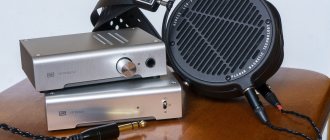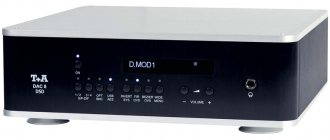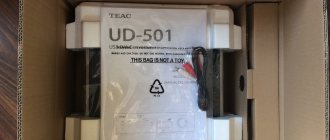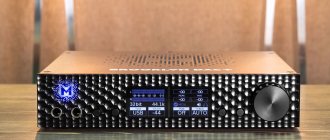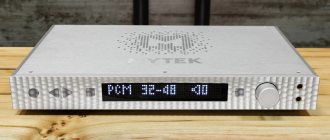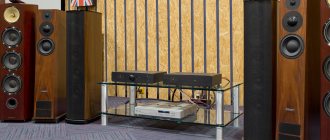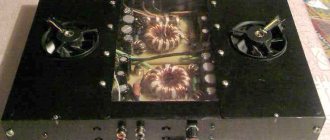Bet on the desired card
To be completely precise, there are three amplifiers with integrated DACs in the current Schiit line, but two of them - Fulla and Fulla 2 - belong to the very entry level. Meanwhile, Jotunheim (in Russian transcription Jotunheim) is a solid device, built using a completely balanced topology. By the way, its name, as usual, is borrowed from the ancient Scandinavian epic. This was the name of the country of the mythical giants, the Jotuns, in which, in addition to the giants, there were witches and female trolls - a kind of solid-stone Amazons. Actually, I associate a small but very weighty metal brick with trolls - powerful, but far from basketball-sized inhabitants of ancient dungeons.
Jotunheim was a pretty harsh place
As for the internal essence of the device, we have before us a combination of a preamplifier and a headphone amplifier, which requires optional hardware expansion by installing an additional board. On the Jotunheim website it is called a “configurable amplifier”, which, in my opinion, is not entirely accurate: the existing analog path cannot be “configured” in any way, except that the gain is switched from 2 to 8 and back.
But you can really expand its functionality, and in two completely different ways. One of the available expansion cards is a phono stage for a vinyl turntable with an MM cartridge, and the second is a DAC with a USB input. This is exactly the option that came to me for testing.
Honest approach
Taking this opportunity, I compared the Magni 2 and Modi 2 kit with the closest models from the branded line. The difference with Fulla 2 was very obvious. Both in controlling complex headphones and in overall quality indicators (resolution, range and dynamic characteristics), the Magni 2 and Modi 2 were clearly better. Well, the result is quite expected. I expected a much less significant difference from replacing Modi 2 with Modi 2 Uber, but here it definitely made itself felt. Detail has increased, the sound has become more focused, clear and voluminous. The step forward turned out to be more than significant to consider the difference in price justified. It's a pity that Magni 2 Uber was not at hand. It would be interesting to compare.
And I would like to end with a slogan: choose high-quality headphones!
In general, the experiment showed that the positioning of Schiit Audio’s products in the line is very fair, and the cost of the devices is truly worth every ruble.
Modules are useful, but dangerous
So, this is not a DAC with an amplifier, but an amplifier with expandable functionality. The concept is interesting and seemingly practical, but there is a strange paradox. No matter how promising and convenient modular devices may seem, they rarely survive on the real market, if not almost never. Suffice it to recall Samsung’s attempts to produce televisions with a replaceable processor module and an external switching unit.
Typical habitat
This happens because developers very quickly realize that making a successful block device and then releasing efficient upgrade modules for it at a reasonable price is a great way not only to please customers, but also to drive their business into the grave. In a word, the bestial grin of capitalism in all its glory.
On the other hand, Schiit's Jason Stoddard and Mike Moffat don't look like market dabblers at all, so why did they decide to play this risky game? The short version of the answer is that their upgrade kits create almost no internal competition in the model line; on the contrary, they help sales.
Well, we will return to the conversation about how they managed to achieve such a non-trivial result at the end of our testing.
A familiar image before the toggle switches
Describing the appearance of Schiit equipment is not a difficult task, but it is a little monotonous. The design remains virtually unchanged from model to model: the front and top panels are made of deliberately rough-polished aluminum, the remaining walls are made of sheet steel, and the regulator drum is clearly turned on a lathe from a solid aluminum billet. A separate topic is switches. Regardless of the price category, all devices use the same miniature toggle switches of exceptionally high quality.
The Jotunheim facade is decorated with two ear ports - for a 6.3 mm jack and for a four-pin balanced XLR. On the rear panel there was a massive 220 V socket, that is, the Jotunheim power supply is internal. Looking ahead a little, I will say that it is linear, equipped with a solid transformer on a U-shaped stacked core. The power switch is also on the back. In principle, it is not difficult to reach it, but as in the case of the top Yggdrasil DAC, the developers recommend simply never turning it off.
The power cord is unnamed, but its thickness and quality were pleasantly surprising
The XLR and RCA connectors of the linear inputs and outputs are also tightly packed here, and next to them there is a rectangular window, from which the USB-B connector mounted on the expansion board looks out (in our case). In its place there could be “tulips” of a phono stage or just a metal plug. By the way, in the latter case the device would have cost 10,000 rubles less.
Secret center of rotation
So, both currently available expansion boards cost 10,000 rubles each and structurally cannot carry more than one or two small connectors. If you look at the photo of the board itself, it will become obvious that there is not too much space on it for internal components. That is, you definitely shouldn’t expect an unprecedented breadth of capabilities and multifaceted functionality from replacement cards. Indeed, the phono stage is designed only for MM cartridges, and you cannot connect to the DAC via S/PDIF.
The transformer is powerful and weighty, the total capacity of the electrolytes in the power supply is more than 70,000 uF
However, the component composition of the additional modules cannot be called defective. The DAC is built using a fully balanced circuit on two AK4490EQ chips from Asahi Kasei Microdevices with a passive output filter and an asynchronous C-Media CM6631A USB controller at the input. The phono preamplifier is also balanced, using AD8599 low-noise opamps. Its gain is 47 dB, the accuracy of the RIAA curve is ± 0.25 dB in the range 20 Hz - 20 kHz.
Miniature removable scarf. But on high-end DACs in balanced mode
As for the circuitry of the amplifier itself, it is a fully balanced differential circuit with current feedback, built on discrete elements using the proprietary Pivot Point topology. What is generally known about it is that Jason Stoddard did not immediately manage to convince even his own team of its viability, and that the technical details about it are kept a big secret.
The phono preamplifier is clearly not designed for vinyl maniacs, but it’s perfect for conscious delving into the subject of records.
So the general public can only be content with the characteristics of the output signals, which, I must say, are impressive. With a balanced connection, 32-ohm headphones deliver 5 Watts of power, which, however, in the asymmetrical version turns into 1.5 Watts. Nonlinear distortions in the operating frequency band do not exceed 0.001%.
PC only
With a USB DAC, it all starts with the USB receiver. This detail, according to some experts, has a very significant effect on the overall sound quality. The Modi 2 uses the CM6631 chip from C-Media. Most people familiar with computers associate this manufacturer with budget sound cards, but that’s what Schiit is all about, to surprise with unconventional, but always effective solutions. This particular chip is far from the most budget-friendly, and it was chosen solely based on its characteristics and quality of work, without regard to its origin.
Rare minimalism. But everything is logical: power from a USB computer does not require a switch
Next to the USB port on the device body there is a switch marked S and E - “Standard” and “Expert” modes. Translated into numbers, the switch gives a choice between connecting with an audio stream resolution of up to 24 bit/96 kHz to work without drivers with any device, including mobile devices, or with a resolution of up to 24 bit/192 kHz, but with the need to install drivers. However, the latter applies exclusively to Windows. Other Mac and Linux users don’t have to worry about this, because in these OSs the DAC is detected without any drivers in any mode.
A mysterious switch near the USB port allows you to connect to Windows without drivers
After the USB receiver in the signal path comes the AKM AK4490 converter from the Japanese manufacturer Asahi Kasei. And at the output we will find an operational amplifier chip AD8616 from Analog Devices, even more understandable to fans of classical audio, precision thin-film resistors and film capacitors (no electrolytes in the signal circuit). This part is quite consistent with the canons of Hi-Fi. And the device housing is, in fact, a small desktop Hi-Fi. They are noticeably heavy and massive. Manufacturers clearly did not spare metal, and even the volume knob is aluminum, not plastic.
USB C-Media converter provides high-quality sound if prepared correctly
If you read the specifications, the main differences between Modi 2 and Modi 2 Uber come down to the presence of optical and coaxial inputs in the latter. At the same time, the difference in price is quite noticeable: the Uber version is one and a half times more expensive, and if you are not going to use SPDIF inputs, decent savings emerge.
But if you take a closer look, you can see one important fact: Modi 2 is powered by a USB cable, while Modi 2 Uber is powered by an external linear power supply. I suggest you just remember this fact for now. In the meantime, we'll move on to the amplifier.
The power of proper nutrition
I started testing the Jotunheim in pure amplification mode, connecting it via balanced inputs to the Asus Essence One MKII Muses Edition DAC. Two pairs of headphones were used: 150-ohm Sennheiser HD 700 and planar 32-ohm OPPO PM-2 with a native set of balanced and unbalanced cords.
The device plays powerfully and thoroughly - the analogies with giants among its creators clearly did not arise out of nowhere. However, with the impressive energy of the bass, they will not get uncontrolled freedom from this amplifier. The delicate control of low frequencies was especially clearly evident on the OPPO PM-2. With excellent microdynamics, these ears tend to shift the tonal balance slightly towards the lows, but when paired with the Jotunheim, there was not an ounce of extra heaviness or inertia in the sound. So Christian McBride's double bass sounded simply luxurious.
A triumph of real metal. Plastic in Schiit devices can only be found where it is needed for insulation
There were no high complaints about detail either; at least within their price range, their purity and transparency of the sound were very impressive. Unbalanced HD 700 with an impedance of 150 Ohms swing easily and confidently; we didn’t even have to move the gain switch to the top position. By the way, the “seven hundredths”, with their manner of not ignoring even the slightest nuances in the sound of strings and percussive brass, still made it clear that the resolution at the top of the device is not unlimited. But I repeat once again, having paid 40,000 rubles, it is simply a sin to complain about such imperfections.
To feel the power, precision and potential in one fell swoop, I play Carl Orff’s Carmina Burana recorded by Deutsche Grammophon. A large symphony orchestra and two choirs at the same time is not an easy task, but Jotunheim copes. Even the dynamics are in perfect order, for which special thanks to the impressive power supply.
Selection of tools
A fairly wide range of headphones were used for testing. I had with me bassy Tonino Lamborghini Quantum HL-01 headphones with a dual speaker and Tonino Lamborghini Spectrum One SE Studio on-ear headphones, which, unlike the serial version, have a well-balanced frequency response. In the Schiit Audio showroom, Beyerdynamic DT-770, Sennheiser HD700, as well as OPPO PM-1 and PM-3 were waiting for me. Not every High End can be approached with such an arsenal, but here, as you can see, you are lucky. And this, by the way, is completely justified. To understand how bad or good a system of this class is, it is best to take several headphones of completely different prices. This is how the limits of the components become most apparent.
A large number of different headphones increases the objectivity of the assessment
Let's start right away with the conclusions. The set copes well with in-ear, inexpensive on-ear or full-size headphones and provides noticeably higher quality sound than the same stereo phones with a smartphone, laptop or computer provided. It makes sense to raise the quality class of headphones to approximately the ORRO RM-3 level. You will be satisfied with the sound of the OPPO PM-1 or Sennheiser HD700 only if you have never listened to these models in a more expensive system before.
How do you like this audio still life? I think it's cute!
During testing, I, one way or another, used the entire arsenal, and for everyday use of Magni 2 and Modi 2, the optimal solution would be headphones whose cost is comparable or slightly higher than the cost of the set. It is important that the amplifier copes very confidently with completely different models, so the choice will be quite wide.
Finding cables can be a problem, because even short wires are redundant for these kids.
Another specific point that I would like to highlight from the very beginning is the choice of USB cable. I had at my disposal two versions of the SOtM Audio USB cable with copper and silver conductors. They are, of course, somewhat expensive for such a system, but it was interesting to determine the DAC’s response to replacing cables. It turned out to be very noticeable. Copper simplified the sound a little and made the sound of the double bass booming; on silver veins, the booming practically disappeared, and the detail was noticeably higher. Therefore, I want to pay special attention to this fact. Changing the cable can be a means of improving sound quality or changing its character.
Atypical figure
Next, I connect the digital source (MacBook Pro with Amarra Symphony player) directly to the input of the DAC board. Dual-channel AK4490EQ converters work in pairs here, so the end-to-end balanced path is still preserved. Let me remind you that these delta-sigma DACs occupy the second position from the top in the elite Verita series, developed by AKM specifically for high-end audio equipment. The chips are interesting with their own signal-to-noise ratio of 120 dB, as well as support for PCM streams up to 768 kHz and DSD up to 11.2 MHz. In this particular implementation, the noise level is –106 dB, PCM streaming is limited to 192 kHz, and Schiit technology does not support native DSD playback for ideological reasons that we have already discussed more than once.
Perhaps, against the backdrop of advanced proprietary multibit solutions like Gungnir, this configuration does not seem like something supernatural, but for a small replacement card it looks and sounds quite solid. Although the system, of course, is far from the cosmic detail and exemplary neutrality of older models. By the way, it seems to me that if Jason Stoddard had chosen to use Saber chips here, then in terms of formal characteristics the sound would have been closer to the leaders. But the idea, apparently, was different - not to introduce sharpness and super detail, which when performed by delta-sigma converters still sound completely different from what Jason prefers to hear, but on the contrary, to make the sound more unified and flexible.
The topology of the rear panel is thought out to every millimeter
Two purely decorative details also support this version. Firstly, through the ventilation grille on the top panel a warm yellow glow is noticeable, which can easily be mistaken for the glow of incandescent filaments of radio tubes. And secondly, when you turn on the device, the sound does not appear immediately, but with a 20-second delay. That is, the developers worked hard to create a tube image for this completely solid-state device.
No, these are not lamps, but luminous semiconductor stabilizers. But we got the hint
However, thank God, they did not artificially enrich the sound with even harmonics. By the way, for lovers of real tube sound, Schiit has a very interesting Lyr 2 in the same weight category. Well, our DAC ended up playing quite detailed, but comfortably and without aggression. Sound images are clear, their positioning in the scene can be read without problems. By the way, when you connect headphones via the balanced input, its volume and transparency, although not dramatically, increase quite noticeably. The bass is quite dynamic and controllable, and in general everything seems to be good, but... With a serious external DAC, the Jotunheim amplification path sounded a class higher in almost all respects.
conclusions
To sum up the overview of this universal component, it is worth noting the flexibility of the Sсhiit Jotunheim concept. It can work normally as a pre-amplifier and pump heavy headphones well (both through the classic and balanced outputs). To ensure full functionality for high-res and DSD, I would still recommend an external source connected via an analog input. The multi-bit DAC module is not exactly my cup of tea, but it will certainly appeal to nostalgic sound lovers disappointed by the bright sound of modern components. And if you don’t like it, then the AD5547 can be replaced with a more neutral board with an AK4490, or you can save money and not install a converter at all.
Advantages : interesting delivery of a multi-bit DAC on headphones, neutral character in the analog amplification path
Disadvantages : the USB DAC section cannot be considered universal, some ergonomic nuances
Official website: Shiit Jotunheim Multibit
Price: 59,000 rubles
